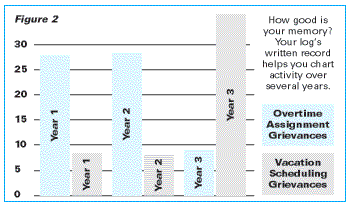A grievance log helps categorize facts
You’ve probably heard the term “information age” used to describe today’s world. When you hear it, you may think of television and mobile phones and the internet all providing the average person with more information than we have ever had access to at any other time in history.
More than ever before, our success in life is determined by how well we manage and utilize information. That’s also true of your success as a steward.
In the last installment, we gave you some insight into how to create an effective filing system to keep information on your grievances.
In this installment, we will give you tips on arranging the files to make them more useful. Specifically, we will discuss a very useful information management tool called a grievance log.
Keeping complete, accurate information on all of your grievances in one central grievance log allows you to track trends, monitor issues, and help administer the collective bargaining agreement.
A Filing System is More Than an Archive of Old Grievances
At this point we hope you have taken our advice and are making sure each grievance has its own unique filing number and that all of the information necessary to handle each grievance is kept in its own folder. For large files, the folder should include an index listing all of the documents in the folder. As you add documents, add them to this list.
The grievance log is a document used to track all grievances you have investigated during the life of the agreement. Just as the index helps you see at a glance what documents are in the folder for any single grievance, the grievance log gives you a quick overall picture of how many grievances have been filed, how often, what departments, what supervisors, what issues, and how grievances tend to get resolved.
Grievance logs can be customized to contain whatever information you think is important to track. Copies of the grievance log can be distributed on a regular basis to stewards and committee people to help them see any new trends that are developing. Grievance logs are also valuable for keeping members informed of their grievances as they move through the process.
Customize Your Grievance Log to Suit Your Needs
The sample grievance log provided on this page (Figure 1) illustrates the basic types of information you might want to track on your logs.
Knowing dates is always valuable. It helps you determine how frequently grievances occur and whether they tend to occur more often at certain times. If you've been getting about one grievance a week and suddenly you're getting five a week, obviously something significant has changed and you need to find out what happened.
Or maybe you notice that the last week of every month you get a lot of complaints about overtime. You need to see if you can figure out why that is happening and put an end to it.
The issue causing the complaint is another key bit of information. When possible, you will want to tie the issue to a specific article in the contract. Clearly, if one area in the contract is causing a lot of grievances, you'll want to address that issue in negotiations. Perhaps the language is unclear. Or maybe the language is clear, but it is unrealistic in your work setting.
The steward who is handling the grievance should be indicated on the log. Not only does this let you know who to go to for information on a particular grievance, it can give you insight into how many grievances each steward is handling. If some stewards are overloaded while others rarely file grievances, you might want to shift some responsibilities.
Including the step that the grievance has reached to date and the final resolution of the grievance lets you see at a glance the progress of each grievance through the process. They also provide valuable information on how many grievances go to arbitration, how many are resolved at each step, and what kinds of resolutions can be expected.
You might also want to track the shift or the department in which the grievance occurs. You might even include the supervisor for each grievance. If any single shift, department, or supervisor is responsible for more than their share of grievances, you might want to investigate why.
When you have all of your grievance information laid out in a table, it is easy to see patterns. If one supervisor gets a lot of grievances over problems with job bidding, while other supervisors don't, your problem is more likely to be with the supervisor than with the job bidding language in the contract.
Similarly, if one steward often gets satisfactory resolutions on discipline-related grievances while your other stewards don’, you need to learn his or her secret and share that knowledge.
Be careful analyzing your information, though. To look at the big picture, you may want to calculate some percentages. For example, let’s say that a quick glance at the grievance log shows you that Ned Barnes, shipping department supervisor, has been involved in twice as many grievances as any other supervisor. Look deeper before you jump to conclusions. If Barnes supervises three times as many workers as any other supervisor, then his grievance ratio is actually pretty good.
Grievance Log
| Number | Date | Article/Issue | Steward | Step | Resolution | Department | Supervisor |
|---|---|---|---|---|---|---|---|
| 02-1 | 1/05 | Art X Overtime | Davis | 2 | 4 hours pd. | Shipping | Marks |
| 02-2 | 3/21 | Discipline | Smith | 3 | Pending Arb. | Qual. Control | Barnes |
| 02-03 | 4/07 | Art VI Job Bid | James | 2 | Denied Committee | Maintenance | Samson |
| 02-04 | 4/28 | Art V Sec 2 Safety | Davis | 2 | Company will provide PPE | Qual. Control | Barnes |
Graphs Help You See Trends
After a bit of time into a new contract cycle, you can begin to build a graphic representation of your grievances. A simple bar graph showing how many grievances have been filed on each issue (and the corresponding article in the contract) helps us visualize problem areas.
For example, if we average one or two grievances a month on overtime, over a year we should have between 12 and 24 grievances. The same should go for other issues. Some articles in the contract may not generate any grievances. This, too, is good to know. Evidently there are not any “trackable” problems in these areas.
Graphs can be reproduced and distributed prior to soliciting our members for proposals for negotiations. We always want more money and more time off, and you will always get these proposals. But what if we are having a significant problem with job bids, or overtime equalization, or some other area? Graphs will reveal these problem areas and we can solicit proposals that may solve the problems.
What if we find out that all of the overtime grievances are in one department or with one supervisor? Our grievance log not only helps us see the problem, but helps us demonstrate it to the company. The company won’t listen if we just say Ned Barnes is a pain in the neck; if we show them a graph of his grievances compared to other supervisors, they may pay attention.
Graphs also help us see trends. Variance from the trend can be indicative of a problem. Figure 2 shows our graph for grievances in two areas, overtime and job bids. Note that overtime grievances were twice as prevalent in years one and two of the contract as vacation scheduling grievances.
Suddenly, in year three, vacation scheduling grievances are up while overtime grievances are down. It's gotten to where you simply cannot take a vacation anymore.
Is this really a problem, or is the company creating a false problem because the contract is getting ready to expire? If they can create a false issue, then solve it in negotiations, they can distract you from the contract's overtime language, which is clearly not working for your members.
Your grievance log and the graphs it helps you create allow you to speak to the company in the kind of language they understand. For example, multiplying the average number of hours a steward spends on a grievance by the average wage tells you how much each grievance costs the company. You can then point out how expensive all those overtime grievances are becoming.
You can also determine how much those grievances are costing the local.
One thing you’re bound to discover if you do this analysis: Grievance logs can be a very helpful tool.





